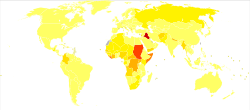Effects of war

Based on 1860 census figures, 8% of all white American males aged 13 to 50 died in the American Civil War, including 6% in the North and 18% in the South.[2] Of the 60 million European soldiers who were mobilized in World War I, 8 million were killed, 7 million were permanently disabled, and 15 million were seriously injured.[3]
.jpg)
During Napoleon's retreat from Moscow, more French soldiers died of typhus than were killed by the Russians.[4] Felix Markham thinks that 450,000 crossed the Neman on 25 June 1812, of whom less than 40,000 recrossed in anything like a recognizable military formation.[5] More soldiers were killed from 1500-1914 by typhus than from all military action during that time combined.[6] In addition, if it were not for the modern medical advances there would be thousands more dead from disease and infection.

On civilians
Many wars have been accompanied by significant depopulations. During the Thirty Years' War in Europe, for example, the population of the German states was reduced by about 30%.[7][8] The Swedish armies alone may have destroyed up to 2,000 castles, 18,000 villages and 1,500 towns in Germany, one-third of all German towns.[9]
Estimates for the total casualties of World War II vary, but most suggest that some 60 million people died in the war, including about 20 million soldiers and 40 million civilians.[10] The Soviet Union lost around 27 million people during the war, about half of all World War II casualties.[11] The largest number of civilian deaths in a single city was 1.2 million citizens dead during the 872-day Siege of Leningrad.
On the economy
Once a war ends, the losing nations are sometimes required to pay war reparations to the victorious nations. In certain cases, land is ceded to the victorious nations. For example, the territory of Alsace-Lorraine has been traded between France and Germany on three different occasions.
Typically speaking, war becomes very intertwined with the economy and many wars are partially or entirely based on economic reasons such as the American Civil War. In some cases war has stimulated a country's economy (World War II is often credited with bringing America out of the Great Depression) but in many cases, such as the wars of Louis XIV, the Franco-Prussian War, and World War I, warfare serves only to damage the economy of the countries involved. For example, Russia's involvement in World War I took such a toll on the Russian economy that it almost collapsed and greatly contributed to the start of the Russian Revolution of 1917.
World War II
One of the starkest illustrations of the effect of war upon economies is the Second World War. The Great Depression of the 1930s ended as nations increased their production of war materials to serve the war effort.[12] The financial cost of World War II is estimated at about a $1.944 trillion U.S. dollars worldwide,[13][14] making it the most costly war in capital as well as lives.
Property damage in the Soviet Union inflicted after the Axis invasion was estimated to a value of 679 billion rubles. The combined damage consisted of complete or partial destruction of 1,710 cities and towns, 70,000 villages/hamlets, 2,508 church buildings, 31,850 industrial establishments, 40,000 miles of railroad, 4100 railroad stations, 40,000 hospitals, 84,000 schools, and 43,000 public libraries.[15]
References
- ↑ "Mortality and Burden of Disease Estimates for WHO Member States in 2004". World Health Organization.
- ↑ Lambert, Craig (May–June 2001). "The Deadliest War". Harvard Magazine. Retrieved 2007-10-14.
- ↑ Kitchen, Martin (2000),The Treaty of Versailles and its Consequences, New York: Longman
- ↑ The Historical Impact of Epidemic Typhus. Joseph M. Conlon.
- ↑ See a large copy of the chart here: http://www.adept-plm.com/Newsletter/NapoleonsMarch.htm, but discussed at length in Edward Tufte, The Visual Display of Quantitative Information (London: Graphics Press, 1992)
- ↑ War and Pestilence. TIME.
- ↑ The Thirty Years War (1618–48), Alan McFarlane, The Savage Wars of Peace: England, Japan and the Malthusian Trap (2003)
- ↑ History of Europe – Demographics. Encyclopædia Britannica.
- ↑ "Population". History Learningsite. Retrieved 2008-05-24.
- ↑ "World War II Fatalities". Retrieved 2007-04-20.
- ↑ "Leaders mourn Soviet wartime dead". BBC News. May 9, 2005. Retrieved January 6, 2010.
- ↑ Great Depression and World War II. The Library of Congress.
- ↑ Mayer, E. (2000) "World War II" course lecture notes on Emayzine.com (Victorville, California: Victor Valley College)
- ↑ Coleman, P. (1999) "Cost of the War," World War II Resource Guide (Gardena, California: The American War Library)
- ↑ The New York Times, 9 February 1946, Volume 95, Number 32158.